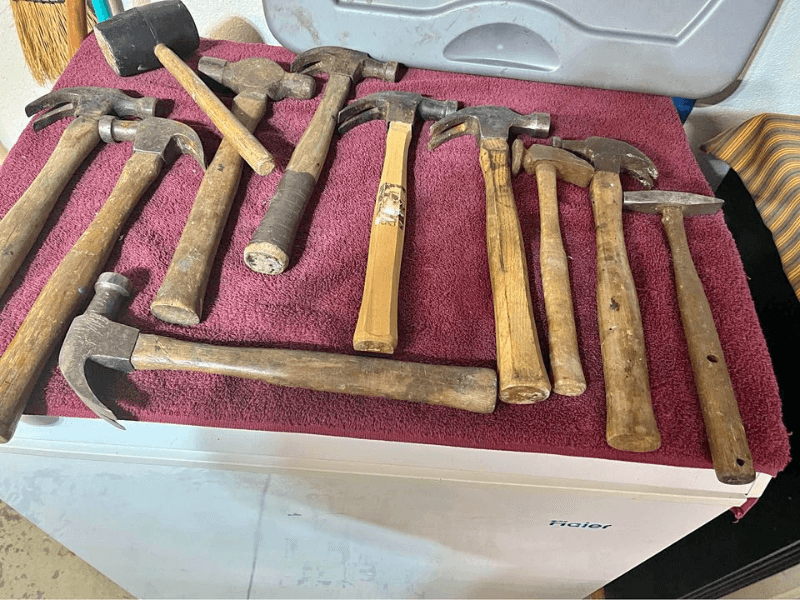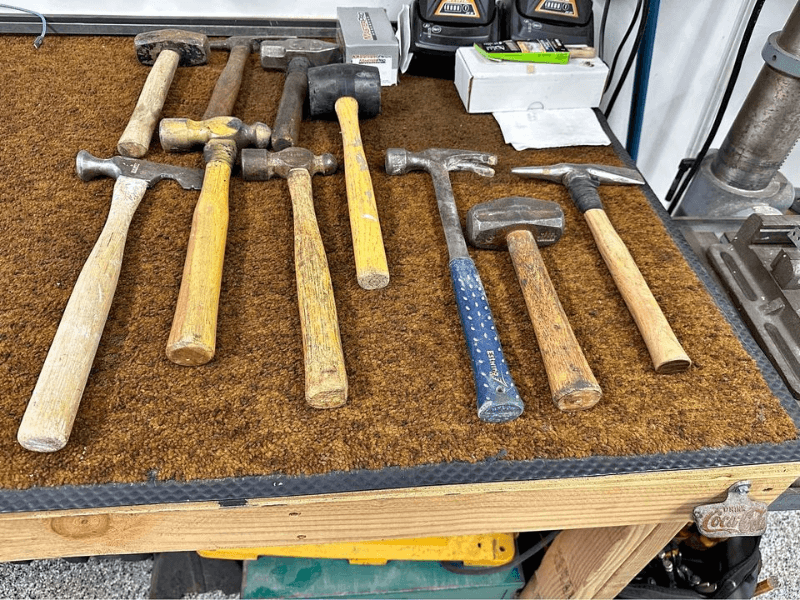When it comes to woodworking, hammers are like loyal companions, always ready to assist in every project. However, there is no one type of hammer for all woodworking projects. We use a variety of hammers to do different tasks. Nevertheless, one of the most common types is the claw hammer. Otherwise, there are hundreds of sorts, which are mostly needed to pry certain items, such as removing nails from a wall, pounding them, or hammering nails into a wall.
There are many options for beginner woodworkers to select from, and they need to determine how they would use the hammers before buying them. Therefore, let us focus exclusively on hammers for use in woodworking.
Types of Woodworking Hammers

Hammers are available in four main types for use by carpenters and joiners.
Claw Hammer
They are available with either a shaft of wood or steel and a handgrip of rubber or leather. They are used for driving medium-to-large nails and can be withdrawn with the claw. For increased leverage when removing nails, I recommend you use a piece of wood as a fulcrum.
This hammer type is the choice for site workers involved in medium-to-heavy construction work. It can, however, prove cumbersome as the size of the nail decreases.
The Warrington or cross-pein hammer
Although it can drive large nails, this is better suited to the middle to lower range, where its cross-pein enables pins to be started more quickly. This hammer is noted for its ease of handling and good
balance. Joiners mainly use it for shop work.
Using the entire length of its shaft requires less effort, and greater accuracy is maintained between blows, thus increasing its efficiency. Tools associated with this hammer are the nail punch and
pincers. Pincers provide the means to remove the smallest of nails.
Engineer’s or ball-pein hammers
the larger sizes are helpful as general-purpose heavy hammers and can be used in conjunction with wall-plugging chisels, etc.
The pin hammer
It is a lighter version of the Warrington. We use this hammer on-site and in the workshop to drive small pins.
Brief History of Hammers
Way back in time, when our ancestors were starting to shape the world around them, an essential tool came into existence: the hammer. This primary tool was a straightforward rock, but it was enough to complete the job.
Fast forward to the Bronze Age, when hammers began to take on a more familiar form, with a handle attached to a solid head. As we entered the Iron Age, hammers became even more refined and specialized for different tasks, from blacksmithing to woodworking.
During the 19th century, the hammer blossomed into many forms and functions. Like axes, they were named after specific trades, operations, or towns that originated the particular pattern. Naturally, each trade favored a specific type of hammer, its weight, or some variation in its shape or size. Some had claws; others had two faces of different forms for driving nails and light riveting.
Handles were made of light wood and specially shaped for gentlemen and ladies. Sometimes 4 feet or longer was needed for reaching way up on walls for a bill hanger’s hammer or stout for heavy sleds. In 1840, David Maydole, a blacksmith in Norwich, New York, took another approach by forging a much deeper eye like that of an adze. He created the so-called Adze eye hammer, which has become the design for nearly all claw hammers since.
Therefore, the modern woodworking hammer we’re familiar with today is a far cry from those early hammers. With a comfortable grip, a sturdy head, and a claw for removing nails, this tool has evolved to accommodate the needs of the modern woodworker.
So next time you pick up your hammer, remember the centuries of craft and evolution that have made it the tool it is today. Here’s to many happy hours of woodworking!
Choosing Your Hammer

So, how do you choose the correct hammer for your woodworking adventure? It’s all about the task at hand. Remember, the best hammer is the one that fits your project and feels good in your grip.
However, when choosing a hammer, consider its weight and handle length. When It’s too heavy, it can tire you out quickly. Too light, and you may need more force for your tasks. A handle that’s too long or short can affect your swing, so try a few and find the one that feels most comfortable in your hand.
You also need to ensure that you are using the hammer correctly. Using a hammer precisely is all about control. Hold it near the end of the handle, not up by the head. Swing it using your whole arm and not just your wrist. Remember, it’s not about brute force but precision and rhythm. Get into the groove and let the hammer do the work.
Finally, consider the handle. Wooden handles absorb shock well and offer a traditional feel. Fiberglass and steel handles are more durable but can be less comfortable. Your choice here really depends on your personal preference.
Your journey is just beginning; these tools are your first steps to creating masterpieces.
The Best Hammers for Woodworking
Estwing hammers are renowned in the woodworking community for their durability and dependability. One of their famous brands is the 16-ounce curved claw with smooth face hammer. This model is perfect for woodworkers who value project control and accuracy.
What sets Estwing hammers apart is their exceptional durability. These hammers are the most durable and longest-lasting striking tools available since they are crafted from a single piece of solid steel and honed into an optimal design. Additionally, the curved claw on this model provides leverage, allowing for added torque when pulling and prying nails or boards.
Versatility is another hallmark of Estwing hammers. They are trusted by framers, roofers, carpenters, contractors, tradespeople, and serious DIYers. This makes the 16-oz. Curved Claw with Smooth Face Hammer valuable for various woodworking projects. In addition to its exceptional performance, the Estwing Hammer prioritizes user comfort. Its molded vinyl handle creates a dimpled grip that is comfortable and durable. Furthermore, this handle design reduces impact vibration by a staggering 70%, making it easier on the user’s hands and reducing fatigue during extended use.
Therefore, when using an Estwing hammer, you’ll find that it’s more than just a tool; it’s an extension of your craft. Over time, you can develop a special relationship with your hammer, relying on its reliability and strength to bring your woodworking projects to life.
If you're searching for a hammer for soft carpentry, look at the Woodstock D2671 8-Ounce Cross Peen Hammer. With its long hickory handles, this well-balanced cross-peen hammer is the perfect tool for upholstery work and all types of tack nailing.
The grip is not only comfortable but also of reasonable quality, ensuring a pleasant user experience.
Another feature that sets this hammer apart is its narrow cross-peen face. This feature allows for easy starting of tacks while holding the hammer between your thumb and forefinger. When it’s time to drive the tack home, you switch to the opposite round face for a seamless finish. This dual-face design makes the Woodstock D2671 a versatile and practical tool for various woodworking tasks.
In addition to its functionality, this hammer is also lightweight, making it easy to handle and maneuver. Its balanced design and ergonomic handle ensure precise control and accuracy in carpentry projects. Therefore, whether you’re a professional woodworker or a DIY enthusiast, the Woodstock D2671 8-Ounce Cross Peen Hammer is an excellent addition to your toolkit, providing you with the precision and control needed for nailing projects.
The Stanley Cp3.1/2 Pin Hammer is the perfect tool for DIY enthusiasts looking for a small, lightweight hammer for driving panel pins or small nails in their woodworking projects. Whether working on a small furniture project or making intricate repairs, this hammer provides the necessary control and accuracy.
One of the great benefits of the Stanley Cp3.1/2 Pin Hammer is its size. It’s small enough to easily maneuver and navigate tight spaces, allowing you to work quickly and precisely. Additionally, it features an Ash Wood handle that offers a comfortable grip, allowing for extended use without straining your hand.
Therefore, Investing in this hammer is an intelligent choice for any DIY woodworker. It’s a reliable and efficient tool that will help you accomplish small woodworking projects faster and more precisely. So, if you need a versatile and convenient hammer for your woodworking tasks, look no further than the Stanley Cp3.1/2 Pin Hammer.
FAQ
How do I choose the correct hammer for my woodworking project?
Consider the type of project you’re working on and the materials you’ll be using. For heavy-duty tasks, a claw hammer is a safe bet. A ball peen hammer may be better suited for working with metal or needing more precision. You can also use it for woodworking and specific tasks. The rounded face on one end and a rounded peen on the other make it ideal for shaping and bending metal.
How do I use a hammer safely and effectively?
Start by wearing safety goggles and appropriate protective gear. To prevent strain and injury, hold the hammer firmly, keep your wrist straight, aim accurately, and strike the surface firmly, letting the hammer’s weight do the work. Never use excessive force, which can damage your workpiece or cause injury. Also, be mindful of your surroundings and keep your fingers clear of the striking zone
Conclusions
A pin hammer is your go-to if you want to work on delicate tasks such as driving small pins and tacks. You can also use it on-site and in the workshop for precision work. Lastly, the cross-peen hammer is your best choice if you are working on middle- to lower-range woodworking projects. Its cross-peen feature enables nails to be started more quickly, making it ideal for rough carpentry tasks.


